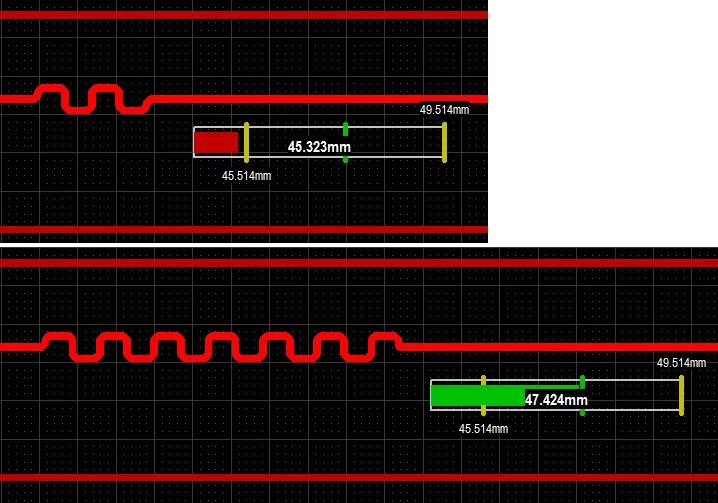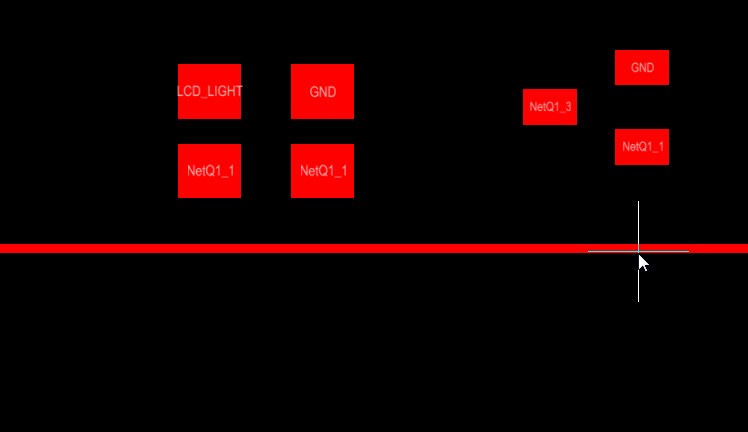Applied Parameters: Action=DynamicallyTuneNetSmartUnion
Summary
This command is used to interactively tune trace lengths of individual nets on the current PCB, providing a dynamic means of optimizing and controlling net lengths by allowing variable amplitude wave patterns to be inserted according to the available space, rules, and obstacles in your design. Accordion style length tuning, also known as serpentine routing, is a standard design technique for high-speed nets with critical timing requirements. It is used to ensure that critical nets have matched lengths, by adding accordion sections to shorter route paths.
For a high-level overview of this area of PCB design, see
Length Tuning.
Access
This command is accessed from the PCB Editor by choosing the Tools » Interactive Length Tuning command, from the main menus.
Use
After launching the command, simply click on existing track for the required net, at the point where you wish to add tuning segments. Filtering will be applied to the workspace to allow better visibility of just that net. As you slide the cursor along the path of the route, length tuning segments will be added. No need to worry if you drift off-course either, as soon as you bring the cursor back over the route, tuning segments will be added up to that point. A length tuning gauge attached to the cursor provides graphical feedback of how close you are to the ideal lengths. The yellow cursor bars indicate the minimum and maximum extents of a valid length range (based on Matched Net Lengths and/or Length rules, where defined). The green bar indicates the target length. The sliding indicator shows how close you are to achieving a match.
The length tuning is created as a smart union of straight or arc segments, with full control over the amplitude, gap, and corner radius (or miter).
Additional actions that can be performed while tuning are:
- Press the Tab key to access the Interactive Length Tuning dialog, from where to define the approach used for defining the target length, and to modify properties of the accordion pattern used in the tuning, on-the-fly.
- Press the Spacebar, or Shift+Spacebar, to cycle forward or backward through the supported tuning patterns, respectively. Available patterns are: Mitered with Lines, Mitered with Arcs, and Rounded.
- Press the , key to decrease the amplitude of the accordion pattern by the amount defined for the Amplitude Increment, in the Interactive Length Tuning dialog.
- Press the . key to increase the amplitude of the accordion pattern by the amount defined for the Amplitude Increment, in the Interactive Length Tuning dialog.
- Press the 1 key to decrease the corner (miter) radius (when using the Mitered with Lines, or Mitered with Arcs accordion patterns).
- Press the 2 key to increase the corner (miter) radius (when using the Mitered with Lines, or Mitered with Arcs accordion patterns).
- Press the 3 key to decrease the gap (pitch) for the accordion pattern by the amount defined for the Gap Increment, in the Interactive Length Tuning dialog.
- Press the 4 key to increase the gap (pitch) for the accordion pattern by the amount defined for the Gap Increment, in the Interactive Length Tuning dialog.
- Press the Y key to toggle Amplitude Direction (starting direction) for the accordion pattern.
- Use the Shift+G keyboard shortcut to toggle the display of the length tuning gauge.
A menu of these interactive commands can be accessed by pressing Shift+F1 after clicking on the target trace.
Controlling the Target Length
The length tuning offers 3 approaches for specifying the target length. These approaches - which can only be defined through the Interactive Length Tuning dialog (press the Tab key while interactively tuning to access) - are:
- Manually defined - you can specify your own target length.
- Based on a net that has already been routed - you can choose a net from existing nets in the design. The length of this net will become the target length.
- Defined by design rules - you need to have one or both of the Length and Matched Net Lengths design rules defined to use this mode. The software will then obey the most stringent combination of these rules.
For a manually defined target length, or a target length defined through a chosen net, bear in mind that if Length and/or Matched Net Length rules exist, they will be used to provide a valid length range, which may be more restrictive that the manual/net defined length.
Relevant Design Rules
The length tuning feature observes the following defined design rules:
- Matched Net Lengths design rule - specifies that the target nets must be routed to the same length as the longest net, within the specified tolerance. It can be a good idea to define a net class containing the nets that you wish to tune, and scope the rule to target that net class. The length tuning tool will then find the longest net in the set of target nets, and give you a valid range of that length, plus or minus the Tolerance specified in the rule.
- Length design rule - complimenting the Matched Net Lengths rule, this rule specifies the minimum and maximum permissable routed length of a net, or set of nets.
Either or both of these rules may be important in your design, it all depends if your potential issues are related to skew (signals arriving at different times - think Matched Net Lengths rule), or the overall signal delay (think Length rule). The length tuning tool considers both Matched Net Lengths and Length design rules when considering the tightest set of constraints. If the maximum length specified by the Length rule is shorter than the longest length targeted by the Match Net Lengths rule (plus the tolerance), then the Length rule wins and its length is used during tuning.
Length Tuning Gauge
Route lengths are tuned with the aid of the Length Tuning Gauge.

Example of the Length Tuning Gauge being used to aid in tuning a route length.
The length tuning gauge display (toggled using the Shift+G keyboard shortcut) includes:
- The Min, Target and Max lengths, as applicable, represented by vertical lines on the gauge:
- Yellow vertical lines - represents the min and max of the valid (permissable) length range. Where applicable Matched Net Lengths and/or Length design rules are defined and enabled, these will be used in calculating the valid range. For Manual or Net-defined target length, and no rules defined (or enabled), length range is not restricted and so the two vertical yellow lines indicate the current route length (on the left) and the target length (on the right).
- Green vertical line - represents the target length, which will either be a manually entered value, a length used from an existing selected net, or the mid-point of the valid length range when calculated from design rules.
- A colored slider, which represents the combined routed length + estimated remaining length. The estimated remaining length is the Manhattan length (the shortest X+Y distance (horizontal + vertical)) from current route end, to the target pad. By including this, you are given a much earlier indication of a net that is unlikely to meet the rule requirements.
As you add tuning segments to a net you are interactively tuning, the colored slider will expand - the aim is to land it as close as possible to the required target length, and within the valid length range (to abide by defined rules!). Good tuning will result in the slider changing from red to green in color.
Smart Union Accordions
The length tuning feature uses accordion sections that are actually smart union objects, which means such a section can be selected, modified and deleted as a single object. To modify an existing accordion section, click once to select it and display the editing handles, as shown in the animation below. Click and drag on an edge or vertex to resize the accordion bounding region — the accordion sections are automatically resized to suit the new updated shape of the bounding region.

Resize the accordion bounding box to create the required accordion shape.
Actions that can be performed while modifying the accordion object are:
- Press the Tab key to access the Interactive Length Tuning dialog, from where you can change the Style, Amplitude and Gap (pitch) for the accordion in non-graphical fashion.
- Press the , key to decrease the amplitude of the accordion pattern by the amount defined for the Amplitude Increment, in the Interactive Length Tuning dialog.
- Press the . key to increase the amplitude of the accordion pattern by the amount defined for the Amplitude Increment, in the Interactive Length Tuning dialog.
- Press the 1 key to decrease the corner (miter) radius (when using the Mitered with Lines, or Mitered with Arcs accordion patterns).
- Press the 2 key to increase the corner (miter) radius (when using the Mitered with Lines, or Mitered with Arcs accordion patterns).
- Press the 3 key to decrease the gap (pitch) for the accordion pattern by the amount defined for the Gap Increment, in the Interactive Length Tuning dialog.
- Press the 4 key to increase the gap (pitch) for the accordion pattern by the amount defined for the Gap Increment, in the Interactive Length Tuning dialog.
- Use the Shift+G keyboard shortcut to toggle the display of the length tuning gauge.
A length tuning accordion, being a union, is a group object - comprised of primitive track and/or arc segments. As with other group objects, such as components, coordinates, dimensions and polygons, a length tuning accordion object can be 'exploded'. In other words, it can be converted into its constituent free primitives, which can then be modified independently. To do so, use the
Explode Length Tuning command.
Tips
- The description region of the Interactive Length Tuning dialog is invaluable for understanding how the length tuning tool is currently configured, and will indicate if there are no valid rules, or which numbers it is using from the rules.
- To prevent adding too many tuning segments, that could result in passing the target length and exceeding the maximum permissable length, enable the clip to target length option in the Interactive Length Tuning dialog.
- The tuning state is also reflected in the PCB panel (when set to Nets mode). The Routed cell for the net being tuned will be highlighted in yellow if the
route length < valid minimum length, clear if the net is within the valid length range, or red if the route length > maximum valid length.
- The easiest way to remove a tuning segment is to simply click to select it, then use the Delete keyboard shortcut.
- If the adjacent accordion sections are too close together for too long, then crosstalk coupling can distort the signal.
- The extent of masking when filtering is applied to the workspace after clicking on the target net, can be manually adjusted using the Dim Control (Masked Objects Factor) slider bar, accessed by clicking the Mask Level button at the bottom-right of the main design window. Clear filtering by using the Clear button, to the right of the Mask Level button.
